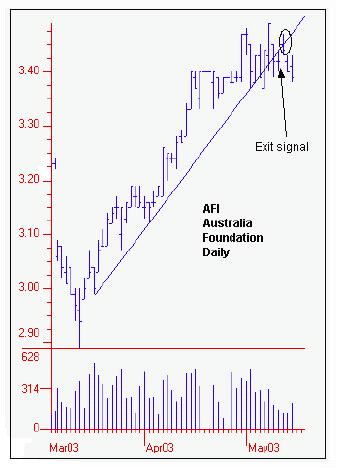- China Trading Statistics
- Darvas Trading
- GMMA Breakout Behaviour
- Happy Easter Holiday
- Holiday Trade Management
- Managing Profitable Trades
- Measuring Returns
- News and Profits
- Placing the CBL Stop
- Recovery made in China
- Secrets of Gold
- The difference between trading
and investing - Trade Exit
- Trading Briefs
- Trading Halt
- Trading IPO's
- Trading Psychology - Getting Perspective
- Using a Private Index
- Using Effective ATR Stops
- Using Equivolume
Articles include:
Some trade exits are simple, and the case study AFI trade is an example of this. The objective of the trade was to identify a Listed Investment Company (LIC) that was outperforming the XJO. This provided an effective way to trade the action of the XJO. It offered a degree of leverage and the opportunity to work with a trend where management performance was delivering a higher rate of return than the underlying market. This was the strategy discussed in several of my newsletters. The tactics are the actual management of the trade. The trend was defined using a straight edge trend line. This was not a particularly complex strategy, and it is easily applied to the comparatively few LIC's which are trending upwards.

Early this month we noted the concern cause by an open below the value of the trend line. This did not call for action, as AFI closed above the trend line. Last week AFI closed below the trend line. We acted on this exit signal the next day, taking an exit for case study purposes, at the open price of $3.45. This delivered a 2.99% return, and added $600 to the case study portfolio. This is not a large return, but it contributes towards building a steady return for the year. Good portfolio returns are based on steady small trades and are supplemented by one or two very good trades. This small return boosted annual realised returns since July 1, 2002 to $70,370 or 70.37% for the period.
We acted on this exit because the trading plan demanded it. We know that the XJO is moving sideways and we anticipate that it will rebound from the support area. Strategically, this suggests that AFI will also benefit from the rebound and that it will probably move at a faster rate. So why exit AFI now?
We do this because the method we used to define the AFI trend has signaled an exit. We might like to guess that this sideways movement in AFI and the market is only temporary, but we do not know for sure. We do know that the balance of probabilities that favoured a continuation of the up trend has now changed. The existing trend is no longer intact. This much we know. We do not know what is likely to happen in the future so we protect ourselves against an adverse price move by taking an exit because the current trend has stalled.
Holding onto the AFI trade because we believe that the XJO will rebound is a gamblers strategy because we do not know with certainty that the XJO will rebound. Nor do we know with certainty that AFI will follow any XJO rebound. If we try to second guess our original trading plan then there is little point in developing a trading plan in the first place.
The plan may be right, or wrong, but unless traders develop the discipline to follow the plan then they have no means to make a consistent and rational exit decision. Unless you follow the plan, all exits become guesswork. When we have the discipline to follow the plan it gives us the ability to ride successful trades to the very end because the discipline keeps us in the trade even when it appears that profits are too large to be sustained.
The strategy of using an LIC to trade the broad market move is a valid strategy. AFI, and other LICs remain on the traders watch lists. If the anticipated rebound in the XJO develops then we may return to AFI as a means of effectively trading the broader market recovery. Before we do this, AFI must be able to show that it has developed a new trend, and a trend that we can feel comfortable in defining using a variety of tools. Traders will first look for evidence of the XJO rebound, and then look for LICs which also show evidence of a breakout from the recent consolidation style activity.
Aggressive traders will buy the first breakouts above these consolidation levels in anticipation of the LIC developing a new up trend.
SUBJECT SUMMARY - GREED AND THE EXIT |